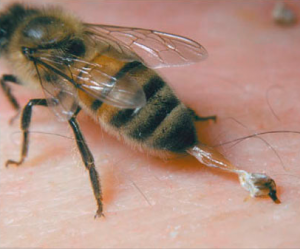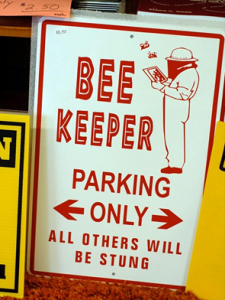Africanized Bees aka killer bees were developed by interbreeding European bees and bees from southern Africa by a biologists named Warwick E. Kerr. They were accidentally released in 1957 and from Brazil they have spread throughout South, Central and deep into North America advancing their range by some two hundred miles per year. Although the venom of Africanized bees is no more toxic than your common honey bee it is the overwhelming response and numbers of stinging bees that makes them so dangerous. Killer bees can be easier to disturb than their counter parts and will stay agitated for up to 24 hours. Foot traffic to close to the hive, loud noises from passing vehicles or lawn mowers are often more than enough to trigger an attack.
What’s Your Tolerance?
It is generally thought that the average adult can sustain up to 500 stings but serious medical conditions will occur thereafter including death. A person under attack should cover their head and run for cover. Please note, these bees often follow victims quite a distance so getting under cover or indoors quickly is crucial. Once safe from further attack the stingers need to be removed to stop more venom from being pumped into their bodies. Scraping the stinger out with a credit card or a dull knife prevents pressure on the venom sac which ‘squeezes’ more toxins into the body.
death. A person under attack should cover their head and run for cover. Please note, these bees often follow victims quite a distance so getting under cover or indoors quickly is crucial. Once safe from further attack the stingers need to be removed to stop more venom from being pumped into their bodies. Scraping the stinger out with a credit card or a dull knife prevents pressure on the venom sac which ‘squeezes’ more toxins into the body.
How do Killer Bees Spread?
This bee spreads by swarming and may travel great distances from the original hive. A new queen bee that has been specially reared leaves the nest and takes with her about 1/2 of the colony. This process is also known as budding and it is the same way which the European honey bee forms new colonies however the killer bee swarms more often. The new queen may lead her colony many miles away or set up in a suitable location much closer. Factors such as population density, abundance of food and water or natural disasters may effect the distance and direction. Since their accidental release this bee has established itself in the south western States to California and as far north as southern Utah. Florida is also an established area for the bee and colonies have been found in Georgia, Louisiana and Arkansas as well.
What Do They Look Like?
 The Africanized bee looks almost exactly like the common honey bee and distinctions are only really evident under laboratory settings or from those with extensive training. The killer bees aggressive behavior is unfortunately the tell tale way in which this bee is most often identified.
The Africanized bee looks almost exactly like the common honey bee and distinctions are only really evident under laboratory settings or from those with extensive training. The killer bees aggressive behavior is unfortunately the tell tale way in which this bee is most often identified.
Treatment and Elimination
Due to the dangers associated with this aggressive bee, I do not recommend any treatment except to call in a professional bee keeper or exterminator if you suspect or find a colony. It’s just not worth the risk!




